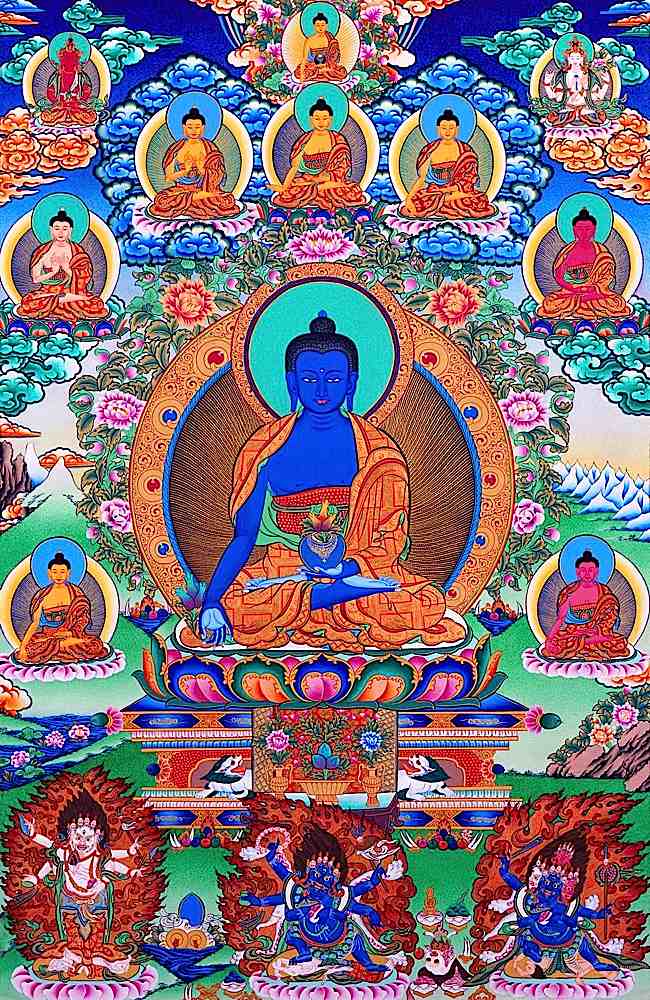Bhaisajyaguru
Bhaisajyaguru ( Skt. Bhaisajyaguru भैषज्यगुरु; Chinese药师 佛/药师 佛, Pinyin Yaoshi FO, W.-G. Yao -shih fo syn: .俾 沙 闍 罗 所/俾 沙 阇 罗 所;药师 琉璃 光 如 来/药师 琉璃 光 如 来;大 医 王佛/大 医 王佛;医 王 善逝/医 王 善逝; jap薬 师 如 来, Yakushi Nyorai; Tib. Sangs rgyas sman bla; vn Phat Dược SU Lưu Li Quang / Phat Su Dược German Medicine Buddha, syn. medicine guru ) is a Buddha of healing, is especially known in Tibetan Buddhism and Japanese Buddhism and in Tibetan medicine. According to the teachings of the Mahayana it cures all diseases, including those of ignorance. Its function is to heal living beings of the three mental poisons. Before his enlightenment the Medicine Buddha made his twelve vows, in which he swore later all Miss educated, the disabled and the sick to get rid of their ailments. These vows are major components of the discourses that are dedicated to the Medicine Buddha.
These mentioned mental poisons cause in living things according to the Buddhist teachings a non-peaceful spirit, so also ( physical and mental ) diseases, thus suffering (dukkha ). He is often depicted to the left of the Buddha Shakyamuni and is associated with the East.
Appearance and Symbolism
Bhaisajyaguru has a blue body and holds in his left hand a bowl of nectar and a healing myrobalan branch with three fruits in the right. These three fruits according to Buddhist belief, the power to neutralize the three inner poisons. It sits in the vajra posture on a lotus. The most lavish Buddha statues are often produced in Nepal, they are covered out of respect for the Buddha particularly in the face with gold paper and are rarely painted blue because blue color is less valuable than gold.
His "birthday" is celebrated in the Chinese calendar on the 30th of the 9th month.
In China, temples are spread honoring the "three great healer ". It is then the Bodhisattva of sunlight on the right, and flanked the Bodhisattva of the moonlight on the left. His pure land is the Chinese净 瑠 璃( Skt. Vaiduryanirbhasa ). Assigned to him are 12 YAKSA generals (Chinese十二 神 将), representing the vows.
Sutras
The only ones left today Sanskrit Sold by Bhaisajyaguru Sutra was in 1931 by Nalinaksha Dutt in Gilgit, Kashmir found.
In the Sino- Japanese canon, there are five Yakushi Sutra Chinese薬 师 经. Under this title, a Nara -time copy was created.
There are other sutras, among other things, in the first half of the fourth century of our era, translated for the first time by Bo Siririmtra. There is also a Tibetan version, which was consistent with the Xuanzang version and translated in the ninth century.
Dharani and Mantra
In Bhaiṣajyaguruvaidūryaprabharāja Sūtra describes how the Medicine Buddha Dharani speaks the following:
The last line of Dharani is the mantra of the Medicine Buddha. In Vajrayana, there are various other mantras also be used.









